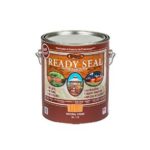There are two main options for preserving and protecting your deck: sealer or stain. So, which one is better? The answer to that question depends on a few factors, such as the type of wood you have, the climate you live in, and how often you plan on using your deck.
This blog post will discuss the differences between deck sealers and stains, so you can make an informed decision about which one is best for your needs.
What is a Deck Sealer?
A deck sealer is a coating applied to wood to protect it from the elements. Deck sealers form a barrier on the surface of the wood, which helps keep moisture out and prevents rot and decay. They can also help make decks look newer and longer by filling in small scratches and blemishes.
Deck sealers are often a transparent/transparent coating covering the wood’s outside surface. The major goal of a sealer is to keep moisture at bay. Water resistance in wood is quite useful since it prevents fungal development and rotting due to unwanted moisture.
On the other hand, water is not the only hazard to your wood.
A deck sealer won’t protect against sun damage. UV radiation can have a detrimental impact on wood exposed to it.
A deck sealer will not prevent the discoloration of a wood surface. Unprotected and persistent exposure to sunlight can cause it to gray and fade.
It also dries out the natural oils in the wood, causing cracking and splitting. A deck sealer will not stop a deck from turning gray or becoming sun-damaged over time.
What is a Deck Stain?
A deck stain is a product that contains pigment, which will color the wood and help to protect it from the sun’s rays. Deck stains come in many different colors, so you can choose one that best suits your style or the existing color of your decking material.
Deck stains protect the wood from water, rain, rot, mildew, and mold. They also include a color pigment or tint to keep the wood from aging due to UV radiation and sun damage. Deck stain is comparable to deck sealer in that it provides more sun protection while lessening wood graying effects.
Stains are water- or oil-based, ranging from semi-transparent to opaque, with darker, more solid hues offering greater UV protection.
A stain may improve the color of the wood and give a more constant palette. The stain will fade over time, so repeat it every 2 to 5 years as needed.
What is the Difference Between a Deck Sealer and Stain?
The difference between a deck sealer and a stain is that a sealer forms a barrier on the surface of the wood, while a stain penetrates it. The type of protection each provides depends on how you want to use your deck.
If you want to keep moisture out and prevent rot or decay, you should use an oil-based sealant; however, if you want to add color and protection, you should use a deck stain.
Deck Sealer vs Stain: Which One is Better?
The answer to this question depends on your needs. A sealer is a good option if you’re looking for basic protection against the elements. However, a stain is the better choice if you want to add color and protect your deck from fading.
No matter which option you choose, apply it following the manufacturer’s instructions for the best results.
Frequently Asked Questions
Do You Need to Seal Wood After Staining?
Sealing wood is an essential final step in the wood staining process. Although stain may protect the wood from some water damage, its main goal is to change the color of natural wood. Without a top seal, the wood is still vulnerable to damage from foods, liquids, human touch, and piercing objects.
A top seal will protect the stained wood from fading, chipping, and peeling. In addition, it will make the surface easier to clean and help to resist stains and peeling. In addition, it will make the surface easier to clean and help to resist stains. Applying a top seal is a simple process that any homeowner can do to protect their investment.
Simply follow the directions on the can of sealer and apply it evenly to the surface of the wood. Once the sealer has dried, your wood will be protected from everyday wear and tear.
Is It Better To Seal Or Stain A Deck?
There are pros and cons to both sealing and staining a deck. Sealing a deck is best for cedar, teak, mahogany, or other quality woods as it enhances the wood grain and natural color. However, sealed decks require more maintenance than stained decks, and the sealant can eventually wear away, leaving the wood exposed.
Staining a deck protects the wood from mold, mildew, moisture, rot, UV rays, and sun damage. It also does not require as much upkeep as a sealed deck. However, stains can fade over time and may need to be reapplied every few years to keep the wood looking its best.
Ultimately, deciding whether to seal or stain a deck depends on personal preference and the type of wood used.
How Long Does Deck Sealer Last?
Deck sealer helps to protect your deck from weathering and wear, but it doesn’t last forever. Depending on your deck’s traffic and the amount of sun exposure it receives, you may need to reapply the wood sealer every year or every three years.
If you live in an area with high humidity or frequent rainstorms, you may need to seal your deck more often to prevent water damage. Likewise, if your deck sees a lot of foot traffic, you’ll need to reapply the sealant more frequently to prevent wear and tear. By keeping up with sealing, you can help extend the life of your deck and keep it looking its best.
Do You Have To Sand A Deck Before Sealing?
When it comes to refinishing your wood deck, sanding is a necessary step to ensure smooth and splinter-free results. Why is sanding so important? It helps to remove any raised wood fibers that can cause splinters. It also gives the stain or sealant a smooth surface to adhere to. And it helps to prepare the wood for accepting a new finish.
If you skip this step, you may end up with an uneven finish that doesn’t last as long. So be sure to take the time to sand your deck before applying any new finishes. Your patience will be rewarded with beautiful results!
How Much Does It Cost To Seal A Deck?
The cost to seal a deck varies depending on several factors, including the size and complexity of the project, as well as the regional cost of labor. Most homeowners spend between $500 and $1,500 to seal their decks. Most of this cost is for labor, which makes up 50% to 75% of the total price.
The type of sealant used also plays a role in the final cost. Some sealants are more expensive than others and may require special equipment for proper application. Finally, the accessibility of the deck can affect the cost of sealing. If the deck is difficult to reach or requires scaffolding, it may be more expensive to seal than a deck that is easily accessible.
Considering all these factors, you can better estimate the cost of sealing your deck.
Conclusion
There are pros and cons to using deck sealers and stains. Ultimately, your best option will depend on your specific needs and preferences. If you want basic protection against the elements, go with a sealer. If you’re looking to add color and protection from fading, choose a stain. Be sure to follow the manufacturer’s instructions for the best results.



